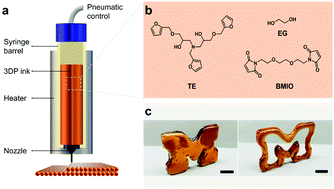3D Printing of a self-healing, high strength, and reprocessable thermoset†
Abstract
Direct ink writing (DIW) is a 3D printing technique that can fabricate user-defined thermoset objects via ink extrusion and solidification. Here we demonstrate the development of a novel ink for DIW that can be used for the fabrication of a high strength, self-healing thermoset. The ink exhibits a tensile strength of 77 MPa after cure, which is comparable to that of engineering-grade epoxies. The low viscosity of the ink effectively eliminates voids between the deposited filaments, thus achieving isotropic mechanical properties of the printed thermoset. The thermally reversible Diels–Alder (DA) reaction between furan and maleimide allows the reversible formation of DA cross-links in the polymer and a high recovery (∼85%) of polymer strength after the first occurrence of damage. Repeatable healing is achieved for the thermoset without a significant decrease in healing performance after three damage-healing cycles. The isotropic characteristic leads to little deterioration in the healing performance of the thermoset printed in different directions, compared with that of the molded ones. Finally, unlike most thermosetting materials, the developed thermoset is reprocessable and can be remolded. This work shows the potential for 3D printing thermosets composed of furan/maleimide monomers to produce strong, self-healing, and recyclable 3D printed materials.



 Please wait while we load your content...
Please wait while we load your content...